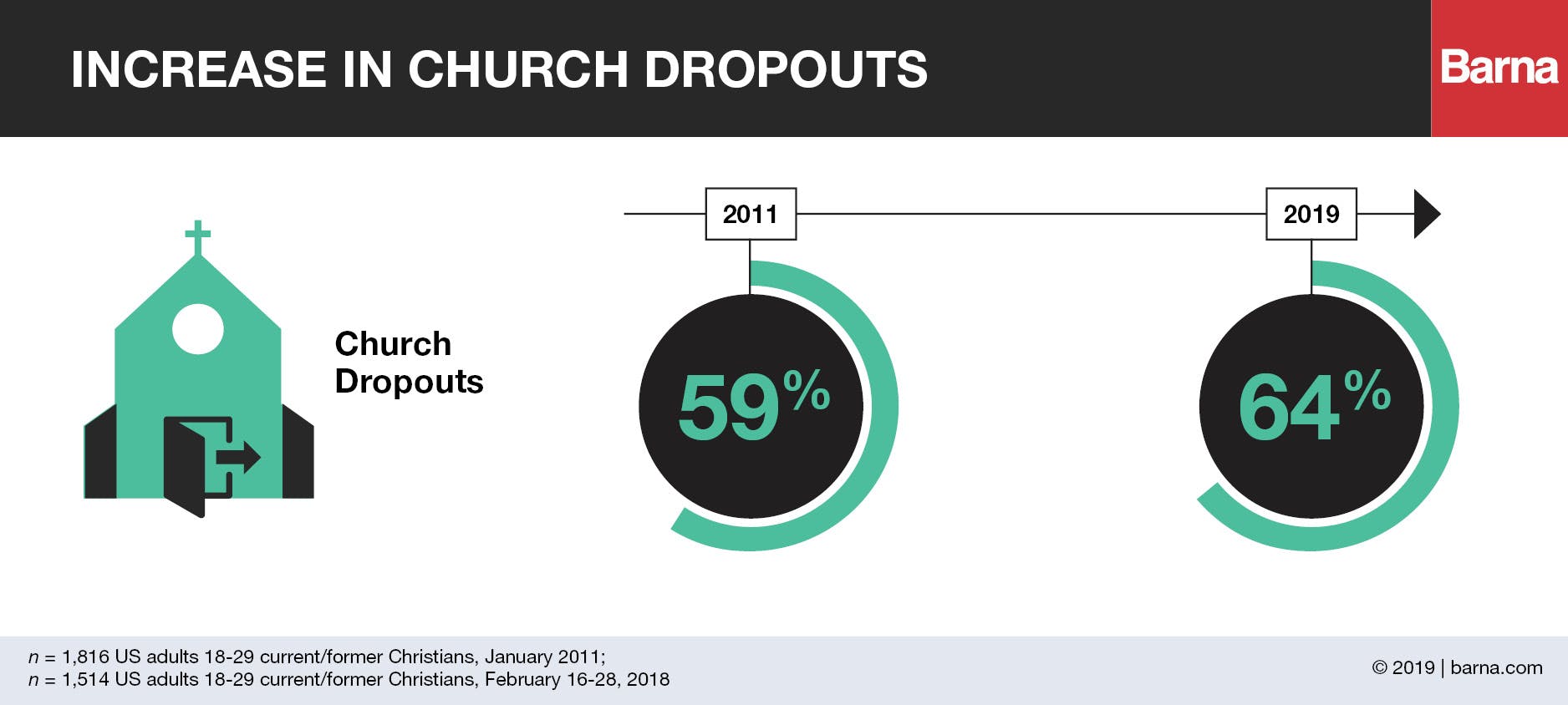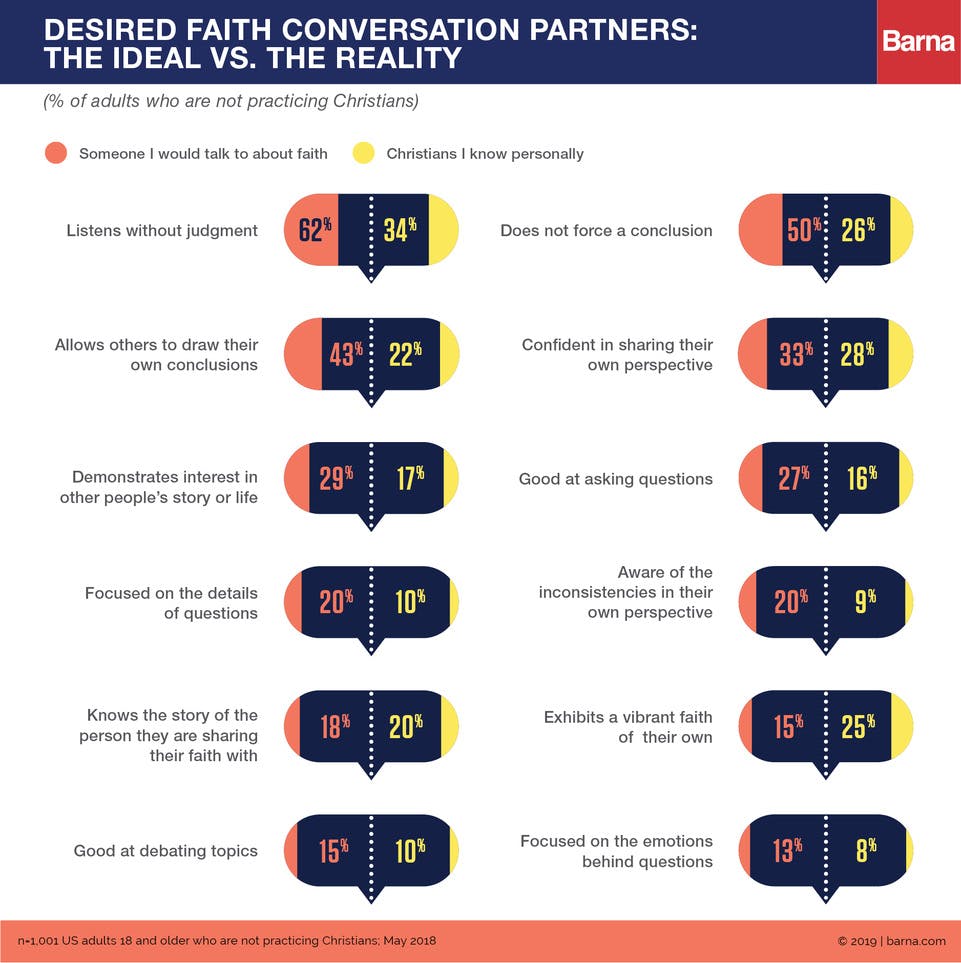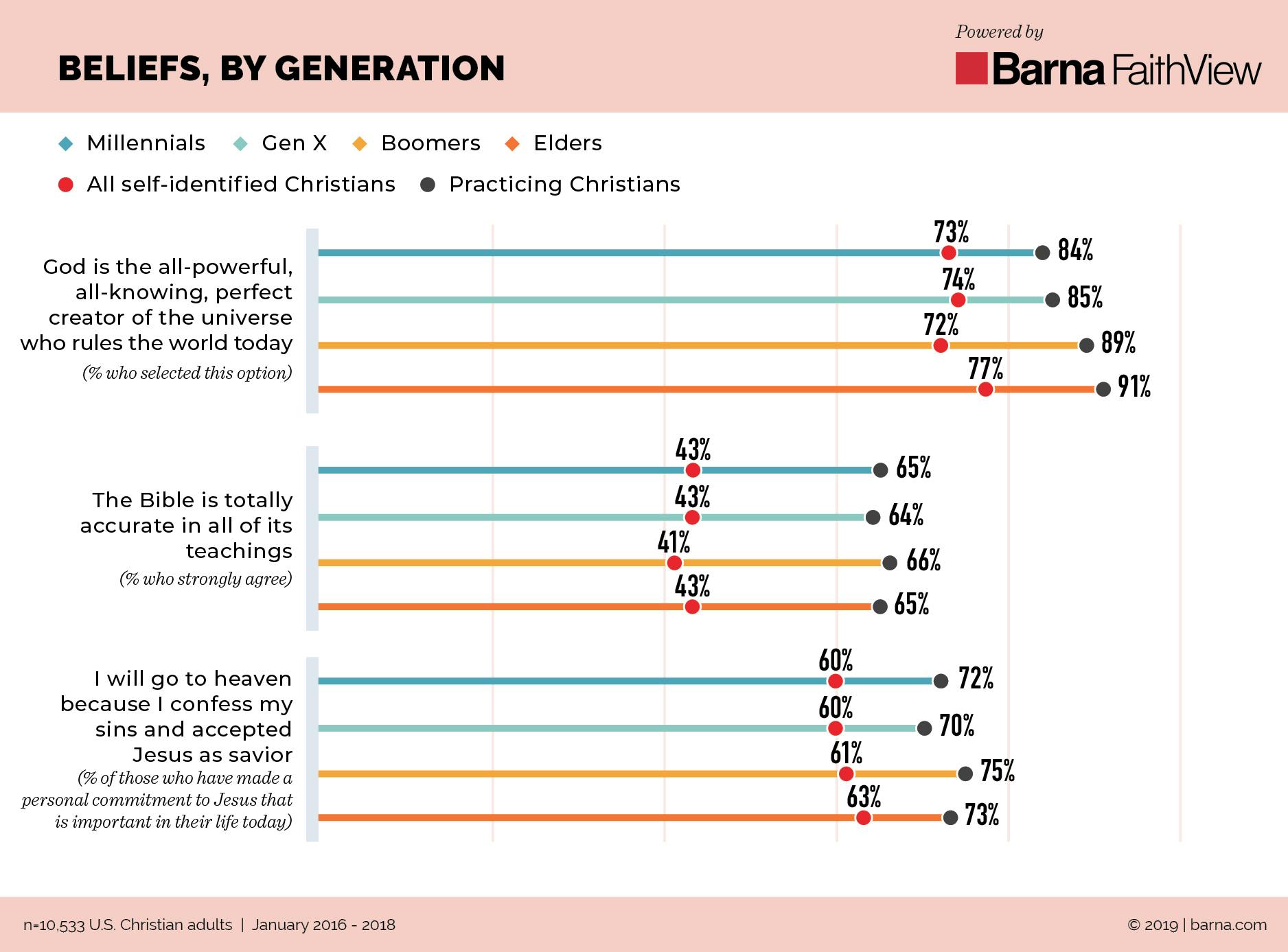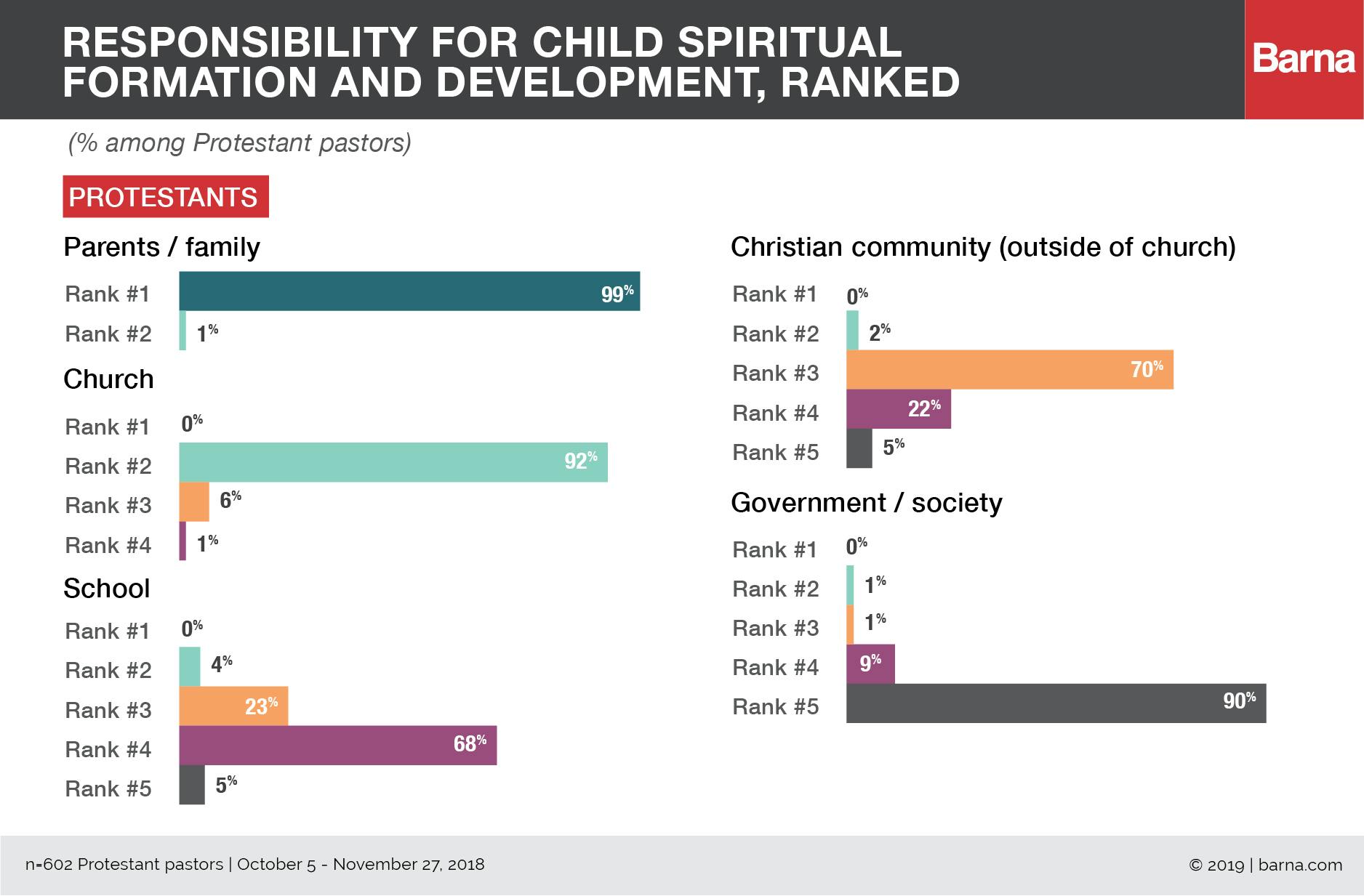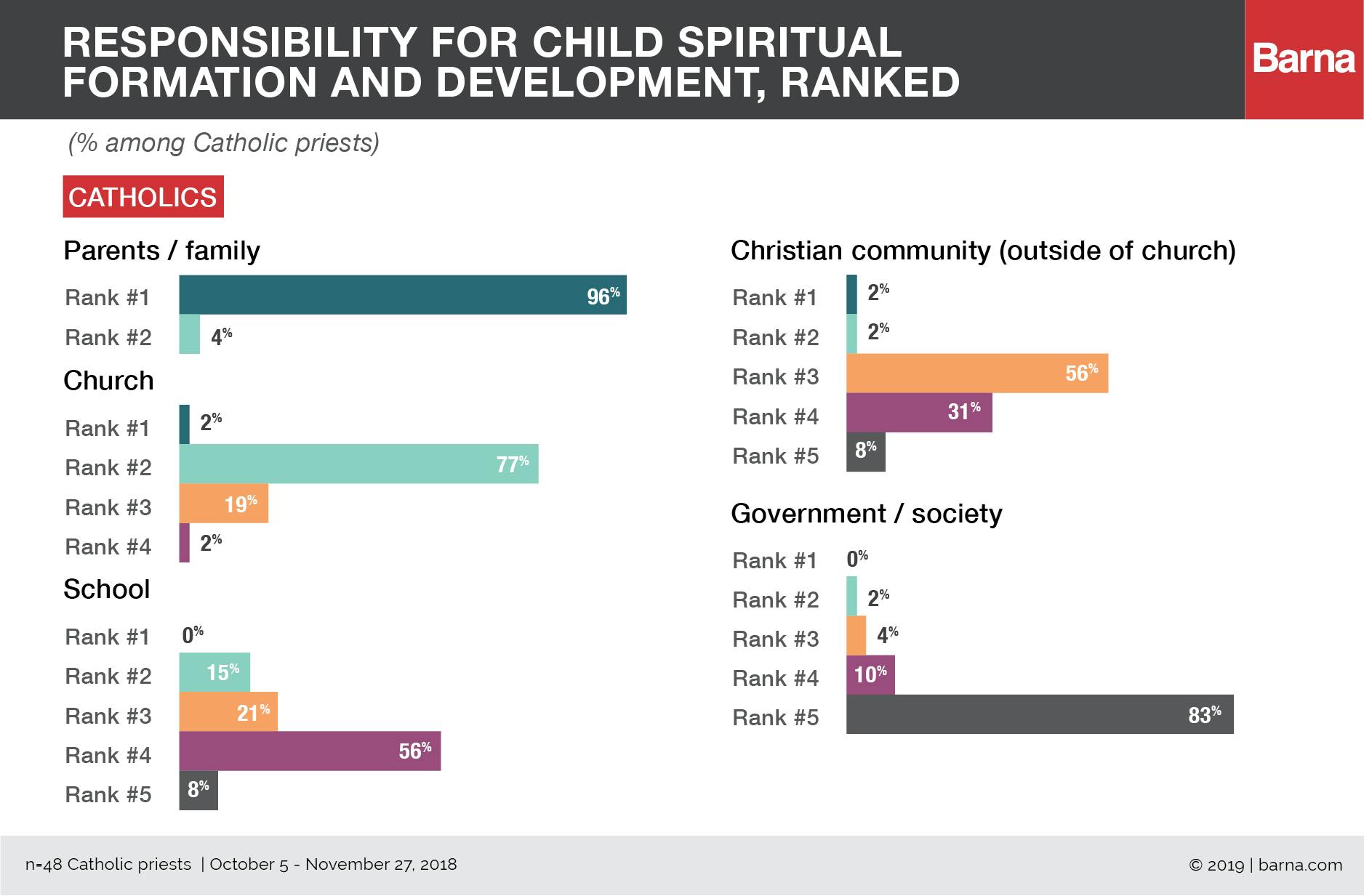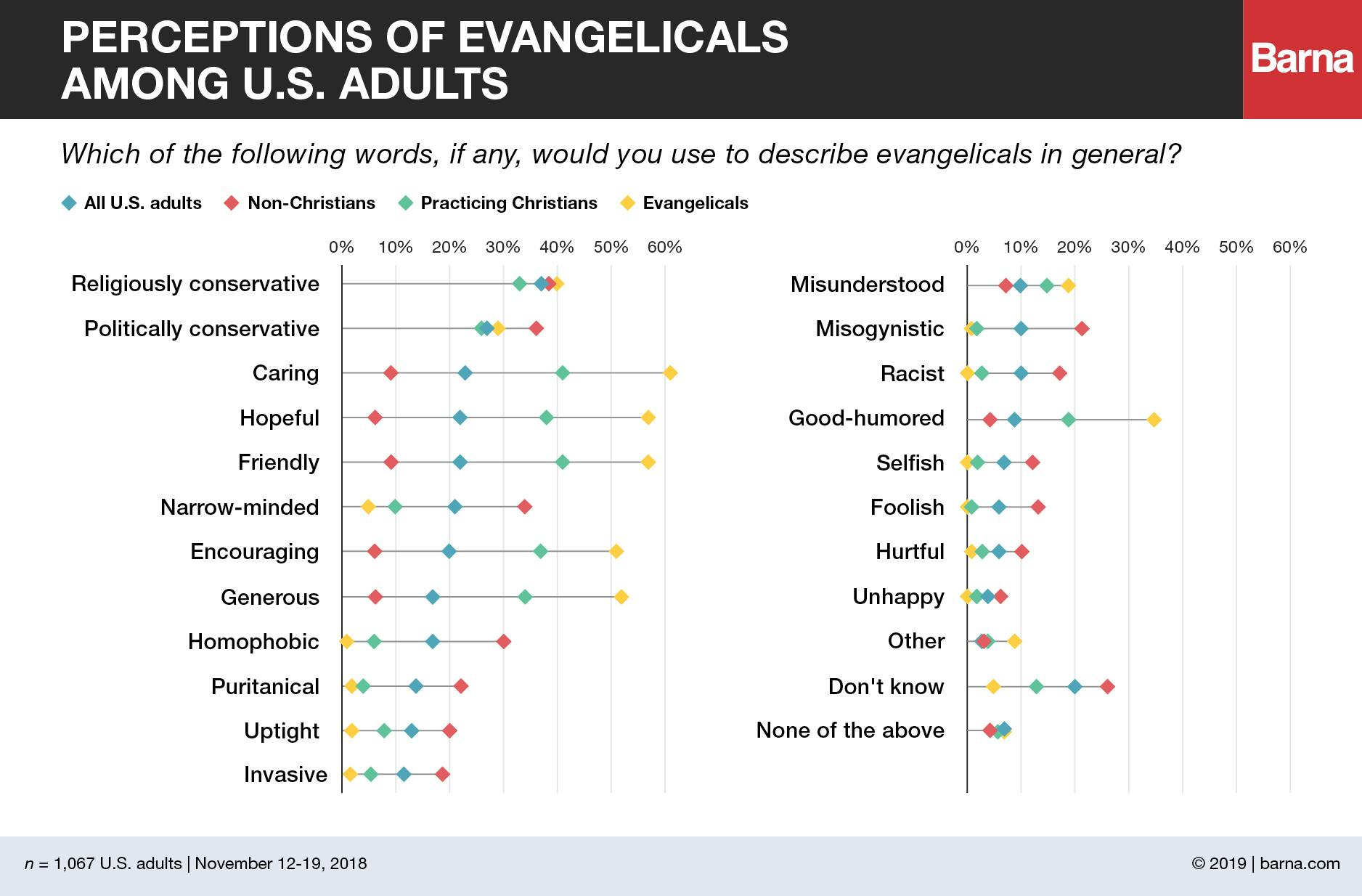
Barna conducts tens of thousands of interviews every year, attempting to make sense of public opinion, cultural trends and religious identity. This year, our most-discussed research and reports were those that strengthened our profile of young adults—not just in the United States but in 25 countries around the globe—and had a particular focus on understanding the forces shaping the future of evangelism and discipleship. To wrap up 2019, we’ve compiled our 10 most popular releases of the year:
1. Almost Half of Practicing Christian Millennials Say Evangelism Is Wrong
Almost all practicing Christians believe that part of their faith means being a witness about Jesus (ranging from 95% to 97% among all generational groups), and that the best thing that could ever happen to someone is for them to know Jesus (94% to 97%). Millennials in particular feel equipped to share their faith with others. For instance, almost three-quarters say they know how to respond when someone raises questions about faith (73%), and that they are gifted at sharing their faith with other people (73%). This is higher than any other generational group: Gen X (66%), Boomers (59%) and Elders (56%).
Despite this, many Millennials are unsure about the actual practice of evangelism. Almost half of Millennials (47%) agree at least somewhat that it is wrong to share one’s personal beliefs with someone of a different faith in hopes that they will one day share the same faith. Throughout 2019, readers and leaders continued to engage with this staggering statistic from our Reviving Evangelism report, produced in partnership with Alpha USA.

2. The Most Post-Christian Cities in America
To qualify as “post-Christian,” individuals must meet nine or more of our 16 criteria (listed below), which identify a lack of Christian identity, belief and practice. These factors include whether individuals identify as atheist, have never made a commitment to Jesus, have not attended church in the last year or have not read the Bible in the last week. These kinds of questions—compared to ticking the “Christian” box in a census—get beyond how people loosely identify themselves (affiliation) and to the core of what people actually believe and how they behave as a result of their belief (practice). These indicators give a much more accurate picture of belief and unbelief in America.
Using Barna’s new FaithView tool, we located this year’s top 10 post-Christian cities in America:

3. What Young Adults Say Is Missing from Church
What do 18–35-year-old Christians who attend church wish was a part of their worship community? The Connected Generation study, in partnership with World Vision, offers a global picture of young adults’ relationship to church. Encouragingly, when asked to identify from a list what might be missing from their church, the plurality response (20%) is “none of the above.” However, nearly one-fifth (18%) says their friends are absent from their church experience. This may be partly due to the fact that religious affiliation and engagement has generally declined among younger adults, particularly in secular contexts—but regardless of the religious climate in which these Christians live, friends are still identified as the main thing missing (20% in secular climates, 18% in Christian climate, 14% in multi-faith climates). Relatedly, social gatherings outside of services (14%), relationship workshops (14%) or support groups (13%) are also among the top things lacking from young Christians’ church experiences.

4. State of the Bible 2019: Trends in Engagement
Each year, Barna examines behaviors and beliefs related to the Bible among American adults, through a study conducted in partnership with American Bible Society. In the 2019 “State of the Bible” report, we find encouraging boosts in Bible engagement and that, despite continued skepticism, scripture still impacts the daily lives and beliefs of many Americans.

5. What Will It Take to Disciple the Next Generation?
Over the last decade and a half, one of Barna’s primary missions has been to understand emerging generations—specifically Gen Z and Millennials in the United States—and discover how to best equip them to grow and share their faith. In the process, Barna has interviewed nearly 100,000 teens and young adults to learn more about their worldview, especially surrounding Christianity, religion and culture. Ahead of our Faith for the Future webcast, we reviewed some of our foundational research of Christianity and identity among the next generation.

Your Leadership Toolkit
Strengthen your message, train your team and grow your church with cultural insights and practical resources, all in one place.
6. Church Dropouts Have Risen to 64% – But What About Those Who Stay?
When Barna president David Kinnaman published his 2011 book You Lost Me, we heard from many people (especially church leaders) who were shocked to learn that 59 percent of young adults with a Christian background had dropped out of church at some point during their 20s—many for just a time, but some for good.
Eight years later, research for Kinnaman’s new book Faith for Exiles: 5 Ways for a New Generation to Follow Jesus in Digital Babylon reveals that the church dropout problem is still a problem. In fact, the percentage of young-adult dropouts has increased from 59 to 64 percent. Nearly two-thirds of U.S. 18–29-year-olds who grew up in church tell Barna they have withdrawn from church involvement as an adult after having been active as a child or teen.
7. What Non-Christians Want from Faith Conversations
Nearly all non-Christians (those who identify with a faith other than Christianity or no faith at all) and lapsed Christians (those who identify as Christian but have not attended church within the past month) have a friend or family member who practices and prioritizes Christianity—but these believers may not be their ideal conversation partners when it comes to faith. For instance, more than six in 10 non-Christians and lapsed Christians (62%) say they would be open to talking about faith matters with someone who listens without judgment—the top quality they value—but only one-third (34%) sees this trait in the Christians they know personally. Similarly, their hopes of talking with Christians who do not force conclusions (50% vs. 26%), demonstrate interest in other people’s stories (29% vs. 17%) and are good at asking questions (27% vs. 16%) appear to go unfulfilled.
8. A Snapshot of Faith Practice Across Age Groups
How often do Christians attend church? What do they believe about God? Do they regularly open their Bibles? Barna has been tracking religious values, beliefs, attitudes and behaviors for 35 years, and in an increasingly secular context, it’s helpful to pause and take stock of the landscape of faith in America today. Drawing from national profiles available via FaithView, this article takes a fresh look at one of the questions we often hear as religion researchers: How do core metrics of faith look by generation, as Christians progress through age and stage of life?
9. Who Is Responsible for Children’s Faith Formation?
Church leaders of all stripes are in agreement when it comes to where the responsibility lies for a child’s spiritual development, according to a Barna study conducted alongside Cardus. Faith leaders universally agree it should start with parents (99% of Protestant pastors, along with 96% of Catholic priests, ranked parents #1), followed by the Church (92% of Protestant leaders ranked it #2, and 77% of Catholic leaders). Seven in 10 Protestant pastors (70%) ranked the Christian community third, and a similar proportion (68%) ranks schools fourth in the chain of responsibility. Catholic priests rank the Church’s responsibility slightly lower than do Protestant leaders and place greater responsibility with schools. Catholic and Protestant clergy alike agree that government and society in general bear the least responsibility for children’s spiritual formation.
10. U.S. Adults See Evangelicals Through a Political Lens
This recent release, excerpted from a Barna briefing unpacking the reputation of evangelicals, has particular significance as we head into a heated election year. The cohort of Christians known as evangelicals has courted controversy, no matter how you slice it—whether evangelicals only make up just 6 percent of the U.S. population (as Barna’s legacy tracking of the group suggests) or whether they comprise a larger share of the public (as other polls, which use different measures, indicate). This Barna study, conducted shortly after the 2018 midterms, shows Americans seem to increasingly view evangelicals through a political lens, which corresponds with mixed feelings toward this religious group—and a stark difference in perceptions among conservatives and liberals.
About the Research
The statistics and data throughout these studies have been drawn from a series of national public opinion surveys conducted by Barna Group. All of the studies were conducted by Barna Group, unless otherwise noted, among a nationally representative sample of the population identified. For a more detailed methodology for each study, see the research methodology in the “About the Research” section in the footer of each respective article.
Photo by Rene Bernal from Unsplash
© Barna Group, 2019
About Barna
Since 1984, Barna Group has conducted more than two million interviews over the course of thousands of studies and has become a go-to source for insights about faith, culture, leadership, vocation and generations. Barna is a private, non-partisan, for-profit organization.
Related Posts

Year in Review: Barna’s Top 10 Releases of 2023
- Culture
- Faith

Year in Review: Barna’s Top 10 Releases of 2022
- Culture
- Faith
Lead with Insight
Strengthen your message, train your team and grow your church with cultural insights and practical resources, all in one place.
Get Barna in Your Inbox
Subscribe to Barna’s free newsletters for the latest data and insights to navigate today’s most complex issues.





